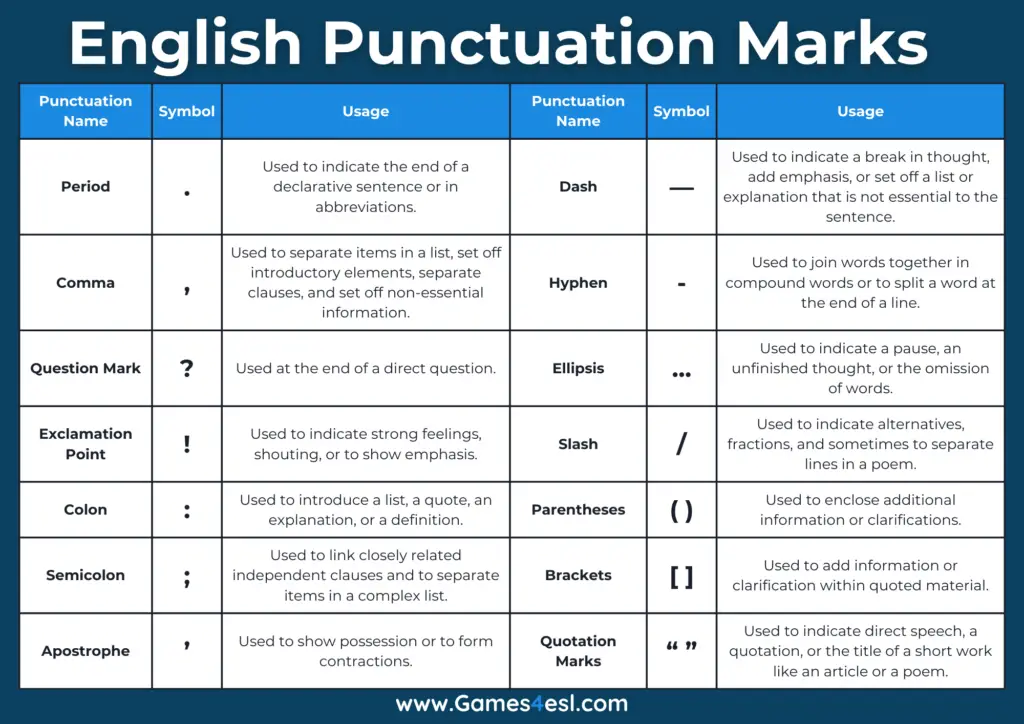Punctuation Marks in English: An Easy Guide to Names and Usage
Understanding and correctly using punctuation marks is essential for English language learners. Punctuation marks play a crucial role in clarifying meaning, conveying emotion, and ensuring the readability of your writing. By mastering the names and uses of these marks, learners can improve their writing skills, enhance their communication, and avoid common misunderstandings. Moreover, knowing the names of punctuation marks enables learners to effectively refer to them and understand when teachers or resources mention specific punctuation.
In this post, you will learn the names of punctuation marks in English, discover how and when to use each punctuation mark, and explore numerous examples that illustrate their correct usage. By the end of this guide, you’ll be well-equipped to use punctuation marks accurately and confidently in your writing. Plus, you’ll be able to download a printable punctuation guide PDF for easy reference.
Related: Punctuation Practice Exercise
How Many Punctuation Marks Are There in English?
There are 14 primary punctuation marks in English. These include the period (.), comma (,), question mark (?), exclamation point (!), colon (:), semicolon (;), apostrophe (’), quotation marks (“ ”), parentheses (()), brackets ([]), dash (—), hyphen (-), ellipsis (…), and slash (/). Each of these marks plays a crucial role in writing, helping to clarify meaning and convey the correct message.
In addition to the primary punctuation marks, there are other symbols used in specific contexts. These include braces ({}), angle brackets (<>), bullet points (•), carets (^), tildes (~), and underscores (_). These additional symbols are often used in technical writing, mathematics, and computing.
Punctuation Mark Names And Usages

Period (.)
A period is used to indicate the end of a declarative sentence. It can also be used in abbreviations.
Examples:
- She went to the store. (end of a declarative sentence)
- Dr. Smith will see you now. (abbreviation)
Comma (,)
A comma is used to separate items in a list, to set off introductory elements, to separate clauses, and to set off non-essential information.
Examples:
- I bought apples, oranges, and bananas. (separating items in a list)
- After dinner, we watched a movie. (setting off introductory element)
- I wanted to go to the park, but it started to rain. (separating clauses)
- My brother, who lives in New York, is coming to visit. (setting off non-essential information)
Question Mark (?)
A question mark is used at the end of a direct question.
Examples:
- What time is it? (direct question)
- What’s your name? (direct question)
Exclamation Point (!)
An exclamation point is used to indicate strong feelings or a high volume (shouting), and to show emphasis.
Examples:
- Watch out! (strong feelings)
- That’s amazing! (emphasis)
Colon (:)
A colon is used to introduce a list, a quote, an explanation, or a definition.
Examples:
- There are three types of rocks: igneous, sedimentary, and metamorphic. (introducing a list)
- He said: “Always do your best.” (introducing a quote)
Semicolon (;)
A semicolon is used to link closely related independent clauses and to separate items in a complex list.
Examples:
- She loves reading; he prefers writing. (linking closely related independent clauses)
- We visited Paris, France; Rome, Italy; and Berlin, Germany. (separating items in a complex list)
Apostrophe (’)
An apostrophe is used to show possession or to form contractions.
Examples:
- Sarah’s book is on the table. (showing possession)
- It’s raining outside. (forming contractions)
Quotation Marks (“ ”)
Quotation marks are used to indicate direct speech, a quotation, or a title of a short work like an article or a poem.
Examples:
- He said, “I will be there soon.” (indicating direct speech)
- Have you read the poem “The Road Not Taken”? (indicating title of a short work)
Parentheses (())
Parentheses are used to enclose additional information or clarifications.
Examples:
- She finally answered (after taking five minutes to think) that she didn’t know the answer. (enclosing additional information)
- The organization (NASA) is known for its space exploration. (enclosing an abbreviation)
Brackets ([ ])
Brackets are used to add information or clarification within quoted material.
Example:
- “She [the CEO] will address the audience shortly.” (adding information within a quote)
Dash (—)
A dash is used to indicate a break in thought, to add emphasis, or to set off a list or explanation that is not essential to the sentence.
Examples:
- He is afraid of two things—spiders and snakes. (adding emphasis)
- She gave him her answer—a firm no. (indicating a break in thought)
Hyphen (-)
A hyphen is used to join words together, such as in compound words, or to split a word at the end of a line.
Examples:
- It’s a well-known fact. (joining words in a compound)
- The runner-up will receive a prize. (joining words in a compound)
Ellipsis (…)
An ellipsis is used to indicate a pause, an unfinished thought, or the omission of words.
Examples:
- I’m not sure what to do… (indicating a pause)
- She began to speak but then paused… (indicating an unfinished thought)
Slash (/)
A slash is used to indicate alternatives, fractions, and sometimes to separate lines in a poem.
Examples:
- Please press the On/Off button. (indicating alternatives)
- The ratio is 3/4. (indicating a fraction)
- She recited, “Twinkle, twinkle, little star/How I wonder what you are.” (separating lines in a poem)
Download English Punctuation Marks PDF
Download this simple guide to English punctuation marks as a printable PDF. It includes the names of each punctuation mark, their symbols, and explanations of their usage.


